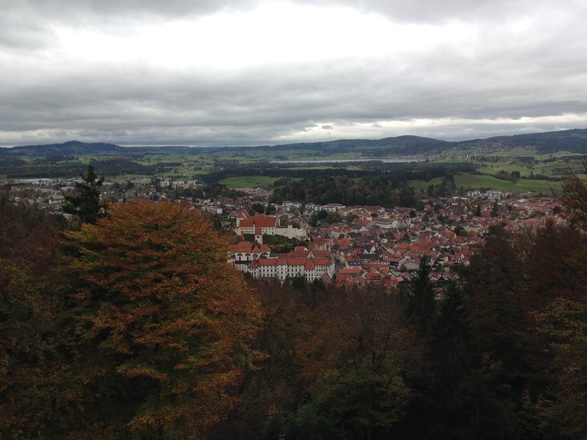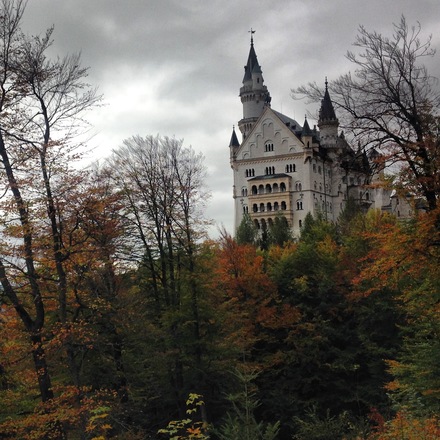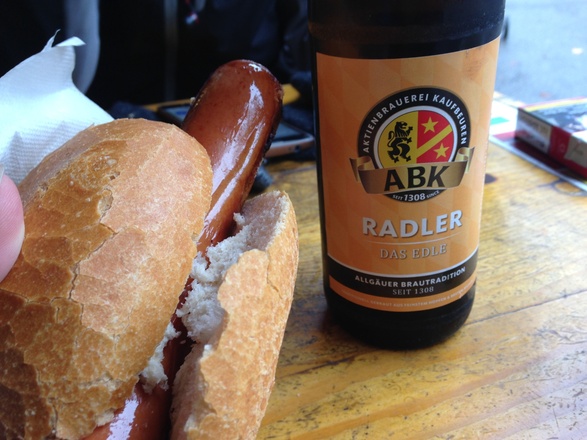| Schwierigkeit |
mittel
|
|
Aufstieg
|
222 hm |
|
Abstieg
|
221 hm |
| Tiefster Punkt | 782 m |
| Höchster Punkt | 933 m |
|
Dauer
|
530:00 h |
|
Strecke
|
18,9 km |
Buching to Füssen
Die Tour
The final stage of the King Ludwig Way is one of the finest hikes in Germany; admire the castles of Neuschwanstein, Hohenschwwangau and the huge chasm of the Pöllatschlucht gorge.
First walk to Hegratsriedersee lake to rejoin the KLW. From here walk along a scenic route with Forggensee to your right and the mountains to your left. Along the way you will get views of the grand castles of Neuschwanstein and Hohenschwangau. After passing the lake of Schwansee, where you get a clear view of the castles behind you, a somewhat arduous ascent is rewarded by a great viewpoint before descending past the Stations of the Cross to Füssen.
There are a few shops along the route where you can buy food and drink. Make sure you take plenty of water for the day's walk. There are also plenty of places to eat and drink in bustling Hohnenschwangau.
Whilst the castles can be visited today, we would recommend booking an extra night in charming Füssen in order to visit the castles, monastery and other attractions in a more leisurely manner. Regular buses and alternative walking routes connect Füssen with the castles.
Info
Karte
Details
|
Kondition
|
|
|
Erlebnis
|
|
|
Landschaft
|
|
| Technik |
Wegbeschreibung
Start
Buching
Ziel
Füssen
Weg
0.00 km - Standing at the crossroads with Romatische Strasse to your right and Fussener Strasse to your left, go STRAIGHT ON towards Berghof along Forgensee Strasse. Continue to a turning on your left by a crucifix.
0.30 km - BEAR LEFT following the way marker sign to ‘Hegratsriedsee 1 1/4 hrs’.Carry on out of the residential area through fields over a crossroads to then reach a crossroads with tennis courts to your right and a bridge to your left.
1.30 km - TURN LEFT following a sign to ‘Hegratsriedsee 50 mins’.Continue on the road bending right and then along a dirt track passing a wood barn to your right. Then go through forest to reach a T junction.
2.80km - TURN LEFT following the sign to ‘Hegratsriedsee 25 mins’.Carry on through scenic pastureland to a T junction.
4.20 km - TURN RIGHT at a T junction following a small yellow way marker sign.Continue down the track, around a gate, to reach the road, with the lake to your left.
4.50 km - TURN LEFT following the K sign to Brunnen (you are now back on the KLW).Carry on, passing Hegratsriedsee lake to your right along a scenic road (watch out for high speed tractors).
Forggensee is to your right in the distance. You will eventual catch views of Neuschwanstein Castle in the distance to your left.Continue on the road to reach a bridge over the river.
8.80 km - TURN LEFT just before the bridge, following the K sign to ‘Tegelbergbahn 1hr’.Carry on along a dirt track with the river to your right. Continue to the second small bridge on your right.
10.30 km - TURN RIGHT and cross the bridge following the K sign to ‘Tegelbergbahn 30 mins’.Continue to the road ahead.
10.50 km - TURN RIGHT at the road, cross the bridgeand then TURN LEFT onto a track alongside the river to your left. Carry on along the track beside the river towards the castle, largely obscured by trees.Go over 3 roads, with bridges to the left, before then coming to a road in front of you.
13.20 km - TURN LEFT onto the road, pass a timber mill to the left and continue on the road to a way marker by a bench on your left.
13.70 km - BEAR LEFT onto the path, following the K sign, through forest; which runs alongside the road and then past a school and playing fields. Carry on to a T junction.
14.40 km - TURN RIGHT following the K sign and continue along a road through a car park (there will be plenty of tourists here) to reach the centre point of Hohenschwangau where you will find a way marker (just before the WC and TIC office).
Alternatively TURN LEFT for a detour to the castle (though be sure to purchase a ticket first). See your information pack for details.
14.70 km - TURN RIGHT following the K sign to ‘Füssen 1 1/2 hrs’.Go past the WC on your left along a cycle/footpath beside a road to your right. Continue to reach a track to your left.
15.40 km - TURN LEFT following the K sign to ‘Füssen 1 1/2 hrs’.(Catch glimpses of the yellow brick Neuschwastein castle above you to your left).Carry on to reach a turning on the right, with the bridge ahead of you.
16.40 km - TURN RIGHT following the K sign to ‘Füssen 1 1/4hrs’.Continue around Schwansee lake, to your left, from where you can see the castles behind you. Carry on to a turning on the right, by an encased meteorite!
16.80 km - BEAR RIGHT and start a very long ascent. Continue on a track that winds uphill.Eventually you come to a path to your right with a K sign to ‘Füssen 40 mins’.
17.40 km - TURN RIGHT onto the path. Zig zag uphill on the path to reach a way marker.
17.60 km - TURN LEFT following the K sign to ‘Füssen 30 mins’. However, you might wish to first explore the viewing point behind you and the end point of the Stations of the Cross, which lead up from Füssen.Now make your way downhill past the stations of the cross, in reverse order, following the K signs to Füssen. Finally descend steps to reach the road.
18.30 km -TURN RIGHT and continue to the bridge, following the K sign to Füssen.
18.50 km - TURN LEFT and cross over. Then go uphill on a cobbled street.BEAR RIGHT at a 3-way crossing and continue to a second 3-way crossing, where there is a fountain in the middle. BEAR RIGHT here too and continue down Reichenstrasse, passing pavement cafés on the left.Carry on along this pedestrianized street to reach road traffic at a crossroads.
19.60 - ARRIVE at the centre of Füssen. Sonne Hotel and the train station are to your left and the TIC office to your right.Congratulations, you’ve reached the end of the King Ludwig Way.
Weitere Informationen
This walk is part of the following itinerary:
WGSKLW1
There are a few shops along the route where you can buy food and drink. You would be well advised to fill your water flask before leaving. There are however plenty of places to eat and drink at Hohnenschwangau. It is quite busy here, so if you like being surrounded by people then this place is for you!
Alternative Transport: Bus from Buching to Füssen (number 73, approx. 30 mins, see http://fahrplan-bus-bahn.de/bayern/fuessen/bus_linie_bus_73 )
Points of Interest
Visiting the grand castles of Neuschwanstein and Hohenschwangau; The unique countryside around Füssen has fascinated rulers and kings throughout the centuries. Proof of this is the more than 60 preserved castles, castle ruins and palaces. These include world-famous Neuschwanstein, the last residence of the legendary King Ludwig II of Bavaria (1845 – 1886). Please see your information pack for extensive details about visiting the castles, or see http://www.neuschwanstein.de/englisch/tourist/index.htm
Neuschwanstein Castle; This fairytale castle, built from 1869 to 1886, was intended as a medieval knight’s castle in the 12th/13th-century style. The outer facade of the gateway was completed in 1873. The main building and the adjoining buildings were faced with Schwangau marble from the quarry at Schwansee. It was modelled largely on the Wartburg in Thuringia. The castle was to consist of five buildings: the gatehouse, the Knight’s Building (the main residential tract) and the keep. The original construction work lasted 17 years and had to be discontinued because of Ludwig’s early death. By then, of the rooms in the main residential tract only the ground floor (kitchen and adjacent rooms), the third floor (the king’s apartments and the Throne Room) and the fourth floor (Singers’ Hall) had been completed. The rooms are richly decorated with works of the arts and crafts, there are portrayals from the Tannhäuser saga, from Lohegrin, Tristan and Isolde, the Nibelungenlied, Parzival and from the life of Walter von der Vogelweide, a medieval German lyric poet. The first concert in the Singer’s Hall was held in 1933 to mark the 50th anniversary of Richard Wagner’s death. Since 1969 the Neuschwanstein Castle Concerts have taken place every year in September.
Hohenschwangau Castle; Less famous, but no less worth seeing, is Hohenschwangau Castle. In particular, the original 19th century Biedermeier furnishings and the Swan Lake Park. The ancient Schwangau castle of “Schwanstein”, which was already dilapidated and uninhabitable when the Schwangau aristocracy died out, was purchased in 1535 by the patrician and Imperial Counselor Johann von Paumgartner zu Paumgarten and completely rebuilt from 1538 to 1547. He gave it the new name “Hohenschwangau”. Almost 300 years later the Paumgarten building was again in ruins. In 1839 the Bavarian Crown Prince Max, the son of Ludwig I, came to the district of Füssen on the occasion of a “history excursion” with his teacher and acquired this crumbling building. He had it rebuilt according to ancient extant plans by the architecture and theatre painter Domenico Quaglio, who, although he originally came from the area of Lake Como, had long since settled in Munich. The whole complex lives in the spirit of the romantic era. Such names as the Swan Knight’s Hall, Guelph Room and Hohenstaufen Room are indications of a living attachment to sagas and history. The Castle Courtyard, with its Mary Fountain, is adjacent to the Castle Garden, which is enclosed by a castellated outer wall. In the centre of a circular flowerbed is a pool with a water-spouting swan.
Lake Schwansee; a serene spot with great views of the castles. Hohenschwangau town; a thriving tourist centre for the castles and the Pollatschlucht (Pollat Gorge) and bridge (latter is closed until July 2016 due to essential works).
The Meteorite at start of the ascent, before reaching Füssen.
Viewing point at the top of the Füssen Stations of the Cross
Füssen Heritage Museum The Füssen Heritage Museum is situated in the south-west wing of the former Benedictine Monastery of St Mang, which together with the Hohes Schloss, constitutes one of the main features of Füssen’s townscape. The former cells of the Benedictine monks house valuable works of art and archaeological finds from the over 1000-year history of this former abbey. http://www.fuessen.de/en/romantic-soul/the-fuessen-heritage-museum.html
The State Gallery in the Hohes Schloss; In the medieval complex of the Hohes Schloss, high above the town, a branch gallery of the Bavarian State Collections of Paintings was set up in 1931 and reopened in 1977. The great Knight’s Hall (Rittersaal) with its splendid carved wooden ceiling from the late 15th century is the setting for a collection of late gothic panel paintings and sculptures from the Swabian-Bavarian and Allgäu region. A large part of the holdings come from Prince von Oettingen-Wallerstein’s collection, which he once sold to the Bavarian king, Ludwig I. http://www.fuessen.de/en/romantic-soul/the-state-gallery-in-fuessen.html
Music Town Füssen In the history of European music Füssen acquired outstanding importance thanks to its lute- and violin-makers. Füssen is regarded as the cradle of lute-making on a commercial scale: in 1562 it was here that Europe's first lute-makers gild was founded. http://www.fuessen.de/en/romantic-soul/music-town-fuessen.html Füssen In the history of European music Füssen acquired outstanding importance thanks to its lute- and violin-makers. Füssen is regarded as the cradle of lute-making on a commercial scale: in 1562 it was here that Europe's first lute-makers gild was founded. http://www.fuessen.de/en/romantic-soul/music-town-fuessen.html
Ausrüstung
A sturdy pair of walking trainers are adequate for this route if you don't wish to wear hiking boots



